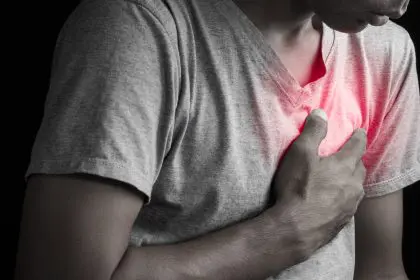A crushing chest pain can trigger immediate fear – is it a heart attack or panic attack? While both conditions share similar symptoms, knowing the difference could save your life. Medical experts emphasize that understanding these distinctions helps people make crucial decisions about seeking emergency care.
Understanding heart attacks
A heart attack occurs when blood flow to the heart becomes blocked, usually from plaque buildup in coronary arteries. This life-threatening emergency requires immediate medical intervention to prevent permanent heart damage.
Common heart attack symptoms include:
- Intense chest pressure or pain that may spread to arms, shoulders, neck, or jaw
- Difficulty breathing, even at rest
- Cold, clammy sweating
- Unusual fatigue or weakness
- Nausea or vomiting
- Lightheadedness or dizziness
- Pain that may develop over hours or days
Cardiologists warn that heart attack symptoms can vary significantly between individuals. Women often experience different symptoms than men, sometimes without the classic chest pain. Some patients report mild discomfort rather than severe pain.
Recognizing panic attacks
Panic attacks stem from the body’s fight-or-flight response, triggering intense anxiety episodes. While not life-threatening, these attacks can feel equally frightening and often mimic heart attack symptoms.
Typical panic attack signs include:
- Sharp or stabbing chest pain
- Racing or pounding heartbeat
- Rapid, shallow breathing or hyperventilation
- Trembling and sweating
- Feeling of impending doom
- Tingling or numbness in hands
- Sensation of choking
- Dizziness or lightheadedness
- Fear of losing control
Mental health professionals note that panic attacks usually peak within 10 minutes before gradually subsiding. While they can occur without warning, many people experience specific triggers like stress, phobias, or traumatic memories.
Critical differences between the conditions
Understanding key distinctions helps differentiate between these conditions during an episode:
Chest pain characteristics:
- Heart attacks typically cause crushing pressure or squeezing pain
- Panic attacks often produce sharp, stabbing sensations
- Heart-related pain frequently radiates to other body parts
- Panic-induced pain usually stays localized
Breathing patterns:
- Heart attack victims experience gradual breathing difficulty
- Panic attacks trigger immediate hyperventilation
- Heart-related breathing problems worsen with activity
- Panic-induced breathing issues improve with calming techniques
Duration and intensity:
- Heart attack symptoms persist or worsen without treatment
- Panic attacks peak quickly and gradually subside
- Heart-related symptoms don’t improve with relaxation
- Panic symptoms respond to breathing exercises and grounding techniques
Emergency response guidelines
Medical professionals recommend treating any chest pain as a potential heart attack until proven otherwise. Here’s what to do in either situation:
If suspecting a heart attack:
- Call 911 immediately
- Take aspirin if available and not allergic
- Remain seated or standing
- Stay as calm as possible
- Note symptom timing and severity
- Wait for emergency services
- Don’t drive yourself to the hospital
During a suspected panic attack:
- Focus on slow, deep breathing
- Remember attacks are temporary
- Use grounding techniques
- Count objects in your surroundings
- Call a trusted friend or family member
- Contact your mental health provider
- Seek emergency care if uncertain
Long-term management strategies
Both conditions require ongoing attention and professional guidance:
Heart attack prevention:
- Regular cardiac checkups
- Blood pressure monitoring
- Cholesterol management
- Healthy diet and exercise
- Stress reduction
- Smoking cessation
- Weight management
- Medication compliance
Panic attack management:
- Professional counseling
- Anxiety medications if prescribed
- Stress management techniques
- Regular exercise
- Adequate sleep
- Trigger identification
- Relaxation practices
- Support group participation
Professional guidance importance
Health care providers stress the significance of proper diagnosis and treatment for both conditions:
- Cardiac testing for heart health assessment
- Mental health evaluation for anxiety
- Regular monitoring of both conditions
- Medication management when needed
- Lifestyle modification support
- Emergency plan development
- Family education and support
- Regular follow-up care
Understanding these differences helps people make informed decisions during frightening episodes. While panic attacks cause significant distress, heart attacks require immediate medical intervention. When in doubt, always seek emergency care – it’s better to rule out a heart attack than risk dangerous delays in treatment.
This story was created using AI technology.














